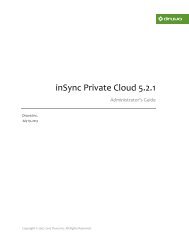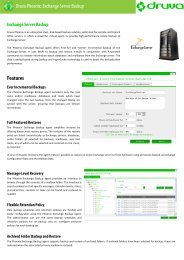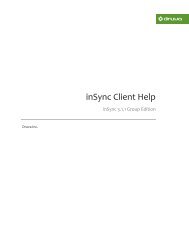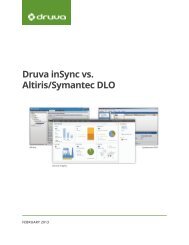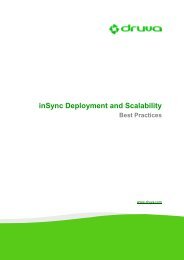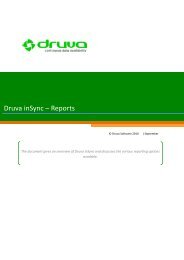inSync Private Cloud 5.2 - inSync Help - Druva
inSync Private Cloud 5.2 - inSync Help - Druva
inSync Private Cloud 5.2 - inSync Help - Druva
Create successful ePaper yourself
Turn your PDF publications into a flip-book with our unique Google optimized e-Paper software.
<strong>inSync</strong> <strong>5.2</strong> <strong>Private</strong> <strong>Cloud</strong> – Administrator’s Guide<br />
Creating a High Availability Policy<br />
To ensure high availability of a primary storage you must create a high availability policy. By creating a<br />
high availability policy:<br />
<br />
You assign a secondary storage to a primary storage<br />
<br />
Select if you want to seed data to the secondary storage from the primary storage<br />
Before you begin: A primary storage can be associated with only one secondary storage. Similarly, a<br />
secondary storage can be associated with only one primary storage. Create the secondary storage that<br />
you want to associate with the primary storage. For more information, see Creating a Storage. It is<br />
recommended that primary and secondary storages are located on separate storage nodes and are of<br />
equal size.<br />
To create a high availability policy:<br />
1. From Manage menu, click High Availability. The Manage High Availability page is displayed.<br />
2. Click Create New. The Create New HA wizard appears.<br />
3. Enter the necessary information in the wizard:<br />
i. On the HA Overview page of the wizard, link the primary and secondary storages and<br />
create a schedule for backup to the secondary storage. For more information,<br />
see Fields on the HA Overview Page.<br />
ii.<br />
On the Seeding Policy page, choose if you want to seed data from the primary<br />
storage to the secondary storage and the frequency of seeding. For more<br />
information, see Fields on the Seeding Policy Page.<br />
4. Click Finish.<br />
174



